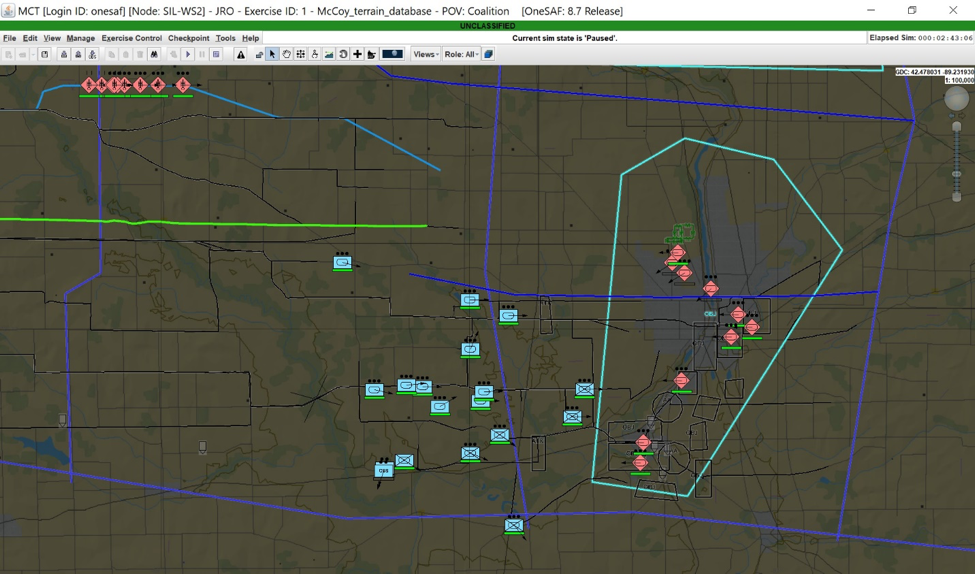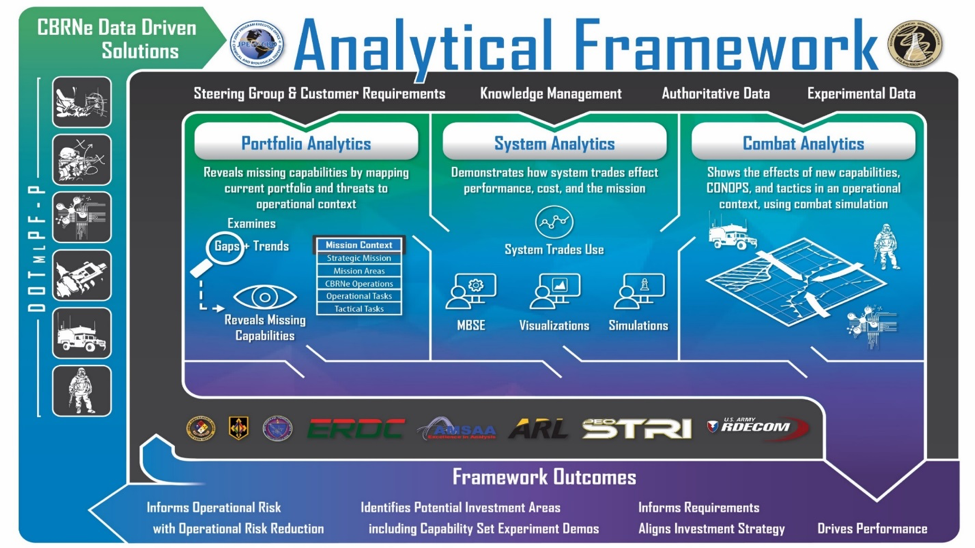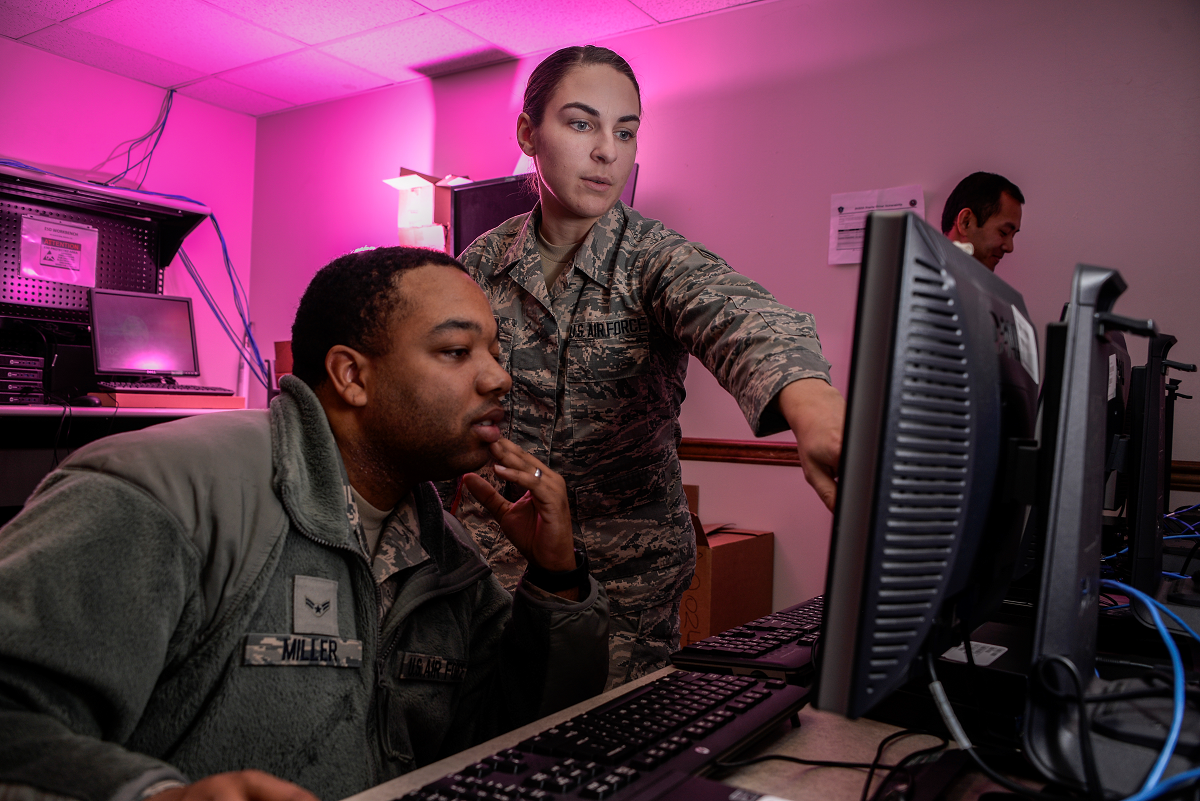
JPEO-CBRND portfolio and systems analysis framework informs future CBRN investment decisions.
by Ms. Gail Cayce-Adams and Mr. Michael Kierzewski
It is simply impossible to maintain the old paradigm of developing new items as single, stand-alone products and retain the U.S. military’s overmatch. It’s no longer reasonable, if it ever was, to develop individual capabilities in a vacuum. Therefore, the Joint Program Executive Office for Chemical, Biological, Radiological and Nuclear Defense (JPEO-CBRND) is moving toward a more holistic, portfolio-based approach to developing chemical, biological, radiological and nuclear (CBRN) warfighter protection with a new analytical framework.
A single capability in the field is just one small part of the toolbox available to our warfighters. So, it is important to consider how all of the available tools work best together to accomplish the mission. Requirements for a new capability may change if the new capability is assessed along with equipment already at play on the battlefield. For instance, if an individual’s protection from CBRN contamination has been greatly improved by the fielding of a new protective suit, what effect does that have on the requirement for a more sensitive CBRN detector? Could it be less important to develop a new detector capable of detecting agents at lower concentrations if a protective suit can be developed that is comfortable and can be worn on a daily basis like any other uniform?
Multiple CBRN risk assessments have shown the need for solutions developed as integrated, layered systems of capability sets. The end result is sets of solutions that span the entire CBRN portfolio. The JPEO-CBRND has created an Analytical Framework—a process that uses a combination of data, analysis methods and software tools to provide insights to support senior level decision-making—to better manage its portfolio of products. The Analytical Framework identifies gaps within the portfolio and systematically assesses new capabilities and how they work in conjunction with other capabilities for wiser investment decisions.
As much as possible, the Analytical Framework replaces subjective and qualitative judgments with objective and quantitative analysis. While the need for subject matter experts will never go away, data-driven analysis can demonstrate for stakeholders which course of action is best and show them why. The Analytical Framework is bolstering traditional approaches of expert panels and tabletop exercises with the insertion of measurable analytical results and data. In this way, personal biases and assumptions can be eliminated from the decision-making equation, leading to better protections against CBRN threats for warfighters in the field.
The Analytical Framework focuses on three key analysis areas: portfolio analytics, which identifies gaps and risks within the JPEO-CBRND product portfolio; system analytics, which demonstrate how system trades affect program cost, performance and mission; and combat analytics, which examine the effects of new capabilities on mission outcomes.

OneSAF operators working in the Battle Lab Simulation Collaboration Environment can see CBRN effects at different geographic locations, including this screen shot depicting an armored force attacking an occupied objective to secure it and prepare for follow-on operations. Thanks to enhancements to OneSAF, the Analytical Framework can evaluate the mission impact of proposed CBRN capabilities to determine return on investment. The impact of a new capability can also be considered in the trade space analysis. (Graphic courtesy of JPEO-CBRND)
WHAT CAPABILITIES ARE WE MISSING?
The Analytical Framework’s portfolio analysis efforts use existing defense guidance and planning resources such as joint publications, field manuals and tactic, technique and procedure documents for each of the military branches to determine the steps necessary to complete a given mission as well as the criteria to use for determining mission success. Then the team breaks down those steps into individual tactical tasks such as attack by fire, conduct dismounted road march and cross a water hazard.
Mapping of each of these tactical tasks back to the capabilities already within the CBRN portfolio needed to complete them then shows where gaps exist in the portfolio. A very simplified example would be a scout on a CBRN route reconnaissance mission: Some of the tactical tasks involved may be detecting whether a contaminant is present along the route and then identifying a clear route for the rest of the force to follow. To complete those tasks, the scout might need equipment such as a CBRN detector, individual protective equipment such as a mask, a suit, gloves and boots, and possibly a CBRN reconnaissance vehicle to help identify a clear route. This equipment can then be compared to what’s available in the JPEO’s portfolio to identify where gaps exist.
We can then analyze the risks involved with those capability gaps and determine how well materiel solutions currently in development mitigate those risks. Findings from this portfolio analysis process are then further examined with a focus on systems analysis and combat analysis.

Three key analysis areas—portfolio analytics, system analytics and combat analytics—feed the outcomes of the JPEO-CBRND Analytical Framework. The framework’s data-driven analysis can demonstrate for stakeholders which course of action is best and explain why. (Graphic courtesy of JPEO-CBRND)
REDUCED COST, OPERATIONAL IMPACT
As much as possible, the Analytical Framework team has aggressively embraced tools that already have been developed by or for other government organizations. The team’s motto for software applications is reuse, don’t re-create. If a tool already has been developed that suits the team’s purposes, the team leverages it rather than starting from scratch. The team goes to great lengths to locate and use tools that already exist. The Analytical Framework team is primarily using the Engineered Resilient Systems Trade Space Analysis Tool (ERSTAT) for systems analysis efforts (http://www.erdc.usace.army.mil/Missions/Engineered-Resilient-Systems/). “Trade space” is the virtual space in defense acquisition where developers can weigh cost, time and capabilities against requirements to look for the best, most rapid result. ERSTAT is a freely available, government-owned tool developed by the U.S. Army Engineer Research and Development Center.
The Analytical Framework team uses ERSTAT to build models of specific systems to demonstrate the relationships among their respective components and requirements.
ERSTAT includes not only a graphical representation but also mathematical relationships between system attributes. These mathematical relationships allow explicit trades between components and requirements. The ERSTAT tool can be used to analyze the effect of trades among thousands of combinations of attributes and to identify solutions that best satisfy the given requirements. As an example, when trying to determine a detector’s trade space in the past, you might plot different attributes to see how they vary with the detector’s size. You might plot the detector’s response time versus its size, then create another graph to see how the detector’s false alarm rate varies with its size, and on and on for all critical detector attributes under consideration. With ERSTAT, you can examine the relationships among all of the attributes at the same time and vary each to see how it affects the others.
ERSTAT allows users to better visualize the trade-offs between solutions and allows full, accurate assessment of solution sets in hours or days rather than weeks or months. It has the added benefit of being able to show a decision-maker who may think the detector really needs to weigh less than five pounds, for example, how that requirement affects other factors such as response time or false alarm rate.
Candidate solutions can then be demonstrated in a combat simulation to further assess them and see what their actual impact is on mission success when considered with all of the other capabilities being used in theater.
NEW VS. BASELINE CAPABILITIES
The Analytical Framework team is using combat simulations to provide a system-of-systems view of CBRN capabilities to determine their effect on mission success—using a repeatable, quantifiable process for both current and proposed capability sets. Combat analysis allows for “what-if” drills to determine how to reduce operational risk using force-on-force simulations. For example, if a new detector were designed to detect CBRN hazards 10 times faster than the currently fielded detector, what result would that have on the number of people killed or incapacitated during a given mission where warfighters are exposed to a contaminant?
The U.S. Army Research, Development and Engineering Command’s Edgewood Chemical Biological Center conducted a market survey in 2015 for the Analytical Framework team to see what combat simulations already existed that included CBRN behaviors and effects. The team chose the One Semi-Automated Forces (OneSAF) simulation because it had some rudimentary CBRN behaviors and effects and is a government-owned, open-source software product that is freely available for use.
In 2016, the Analytical Framework team worked with the U.S. Army Materiel Systems Analysis Activity and the Edgewood Chemical Biological Center to identify gaps in the current CBRN representation within OneSAF. The JPEO-CBRND then partnered with the Program Executive Office for Simulation, Training and Instrumentation (PEO STRI), which develops OneSAF, and funded the first increment of CBRN behaviors and effects enhancements to the simulation. This initial effort provided sufficient representation to support near-term proof-of-concept CBRN analysis efforts.
In FY17, funding was provided by both JPEO-CBRND and PEO STRI to develop a second increment of enhancements to OneSAF to address additional shortfalls and further refine the CBRN behaviors and effects that were added in the first increment. Additional funding has been provided by the Army Modeling and Simulation Office to allow PEO STRI to add the capability to federate the CBRN enhancements across the Battle Lab Simulation Collaboration Environment in support of the experimentation community. This allows all OneSAF operators on the collaboration environment that are at different geographic locations to see the CBRN effects, such as a chemical attack.
With these CBRN enhancements to OneSAF, the Analytical Framework has now begun to evaluate the mission impact of proposed new CBRN capabilities compared with existing capabilities to determine return on investment and to include a new capability’s mission impact as a tradable parameter in trade space analyses. The team is also examining the mission impact of capability sets to see how different proposed capabilities interact with one another as well as other combat equipment in theater. Results from this analysis, such as reduction in casualties or ability to complete the mission, can then be passed back to the systems analysis trade space evaluation tools to further refine solutions.

Airman 1st Class Tevin Miller and Airman 1st Class Amanda Button, 707th Communications Squadron client system technicians, update software for computers that will be used on Air Force networks in January at Fort Meade, Maryland. Joint forces, coordinating from command centers to the warfighter in the field, will use integrated software systems that allow for early warning and situational understanding. The Analytical Framework’s goal is to get capabilities like these into the hands of warfighters sooner. (U.S. Air Force photo by Staff Sgt. ¬Alexandre Montes, 70th Intelligence, Surveillance and Reconnaissance Wing)
CONCLUSION
The JPEO CBRND’s Analytical Framework concept represents a shift in the way of doing business for the defense acquisition community. This concept embraces DOD initiatives to speed up the acquisition process and get new, more effective capabilities into the hands of warfighters sooner. The Analytical Framework approach permits better-informed decision-making through the use of quantitative analytics and fosters fiscal responsibility by fully evaluating system designs and proposed new capabilities early in the acquisition life cycle when the greatest cost savings can be achieved. This approach is quite simply a smarter, more efficient way of doing business.
In addition, the JPEO-CBRND approach to standing up the Analytical Framework has been to reuse, not re-create, by leveraging existing government-owned tools whenever possible and partnering with other organizations for the mutual benefit of all involved. The Analytical Framework has benefited from the expertise of its partner organizations, and those organizations have gained access to the tools and software developed by or for the Analytical Framework.
The Analytical Framework is expecting a third round of enhancements to OneSAF to be completed and released by PEO STRI in July 2018. In addition, the Analytical Framework is developing text analytics applications to assist with searching military publications and decomposing missions to the tactical task level, as well as working to incorporate more of the functions available within the Engineered Resilient Systems tool in its systems analysis efforts.
The JPEO-CBRND Analytical Framework concept could be applied by all defense acquisition programs to help determine where capability gaps exist within their portfolios and what solutions for filling those gaps will provide the most bang for the buck. This process provides data-driven analysis early in the acquisition process to help determine the best solutions for new capabilities.
For more information, contact Lori Remeto, director of strategic analytics for JPEO-CBRND, at lori.c.remeto.civ@mail.mil.
GAIL CAYCE-ADAMS is an operations research analyst with JPEO-CBRND and a member of their Analytical Framework team. She holds an M.S. in systems management and operations research from the Florida Institute of Technology and a B.S. in computer science from the University of Maryland, Baltimore County. She is Level III certified in engineering and Level I certified in program management.
MICHAEL KIERZEWSKI is the branch chief for modeling, simulation and analysis within the Edgewood Chemical Biological Center and serves as a consulting member of the JPEO-CBRND Analytical Framework team. He has an M.S. in operations research from the Naval Postgraduate School and a B.S. in chemical engineering from Virginia Tech. He has been performing operational effectiveness analyses on CBRN materiel and concepts for about 30 years.
Related Links:
Edgewood Chemical Biological Center website
Edgewood Chemical Biological Center 2016 review discussing the Analytical Framework
This article will be published in the July – September 2018 issue of Army AL&T magazine.
Subscribe to Army AL&T News, the premier online news source for the Acquisition, Logistics, and Technology (AL&T) Workforce.







